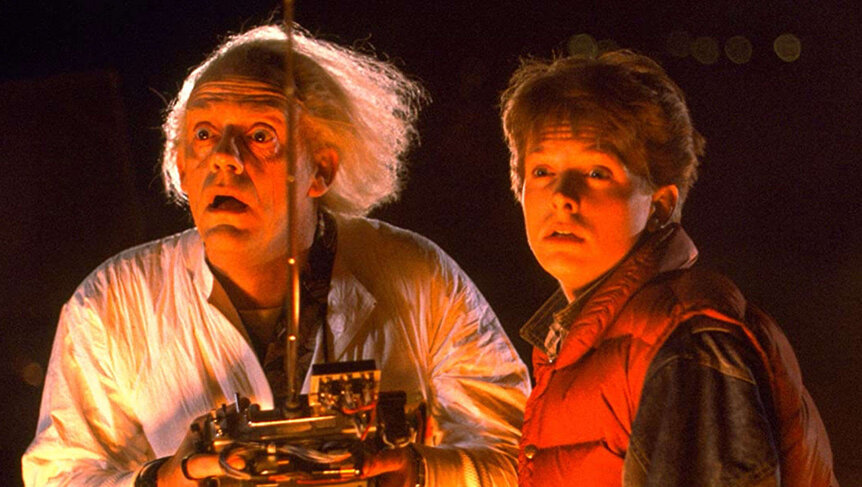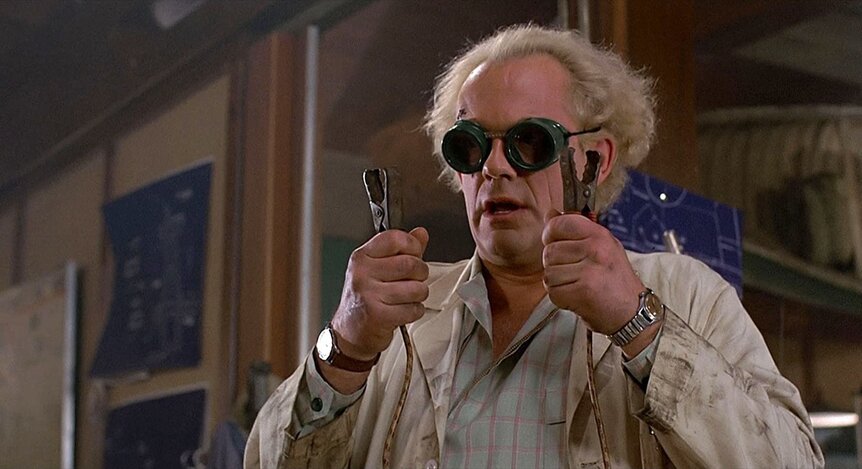Create a free profile to get unlimited access to exclusive videos, sweepstakes, and more!
How Much Power Is 1.21 Gigawatts, Anyway? The Science Behind Back to the Future
The DeLorean time machine got TERRIBLE gas mileage.

When Doc Brown (Christopher Lloyd) built his DeLorean-shaped time machine in Back to the Future (now available from Universal Pictures Home Entertainment) he needed an incredible amount of raw, concentrated energy to power it. After testing his invention, the doc topped it up with a full tank of stolen plutonium right before his partner in time, Marty McFly (Michael J. Fox), accidentally sent himself 30 years into his past, landing in 1955.
Unfortunately, refined plutonium wasn’t exactly readily available in 1985 and things were even more difficult three decades prior. If you need a refresher on why nuclear materials might have been hard to get your hands on circa 1955, check out Christopher Nolan’s award-winning biopic Oppenheimer.
In an attempt to get Marty back to the correct time, the ‘55 version of Doc Brown gets advice from his future self, by way of Marty’s home video camera. On the tape, future Doc says, “I need a nuclear reaction to generate 1.21 gigawatts of electricity…,” and past Doc flips his lid, “Great Scott” and all. He calls himself careless, and laments that generating that amount of energy can’t be done. According to the doc, “the only power source capable of generating 1.21 gigawatts of electricity is a bolt of lightning.” Fortunately, they’ve got one lined up.
For More on Electricity:
The Secret Language of Mushroom: How Fungi Use Electricity to Speak
Lightning Bugs! Insect Swarms Produce as Much Electricity as Rain Clouds
Scientists Have Achieved the First Ever Energy-Positive Fusion Reaction! So What Does That Mean?
What Is a Watt, a Kilowatt, a Megawatt, and a Gigawatt?
A watt (W) is the internationally recognized individual unit of energy transfer. You might remember hearing that a calorie is the amount of energy needed to heat one gram of water one degree. The energy unit of a watt is similarly defined as the amount of energy it would take for an object moving at one meter per second to push against another object with a force of one newton.
That’s not an intuitively helpful definition in the same way the calorie definition is, but we can relate it to real-world experience in other ways. You’ve probably heard the term “watts” in reference to light bulbs. You can select from bulbs of variable wattage and get a different level of light from each. A 100-watt bulb will pump out more light than a 40-watt bulb but it will also use more energy, as its name implies.
A 100-watt bulb is so named because it uses 100 watts of energy for every hour of operation. Put another way, 100 watts is the energy it takes to power a lightbulb for one hour (it’s also the average power generation of the human body), that’s an easier basic unit for our minds to build from.
Multiply that by 10 to get 1,000 watts and you have a kilowatt. That’s roughly what it takes to run your average microwave or hair dryer. Multiply by 10 again to get to 10,000 watts and that’s about what you’d need to charge an electric car for an hour. Alternatively, you could just light up 100 light bulbs in your living room. Either way, you’re burning through about 10,000 watts per hour.
Moving on to a million watts, otherwise known as a megawatt. You could charge 100 electric cars or power 10,000 light bulbs for an hour. It’s a lot of energy and we can do a lot with it. A megawatt is enough energy to power the average American home for 36.5 days, or about 1.2 months. Ten Megawatts will keep your lights on and your refrigerator cold for about a year.
We’re still nowhere close to a gigawatt, we’ll need 1,000 megawatts to get there. That’s enough electricity to keep the average American home powered up for 100 years. It is literally a lifetime of energy all wrapped up in a bow. A gigawatt is roughly what the average nuclear power plant pumps out in a day, a billion watts, and Doc Brown wanted to burn it up and then some, cruising through the spacetime continuum.
Powering the DeLorean would take 2.5 million solar panels or 310 large scale wind turbines, according to the Office of Energy Efficiency and Renewable Energy. It would have the equivalent power of 1.3 million horses kicking a hole in the fabric of reality. As for lightning, the average bolt carries an estimated 10 gigawatts of electricity, more than enough to blast you back to the future.
If you’re not keen to put yourself in the path of a lightning bolt, you can get Back to the Future now from Universal Pictures Home Entertainment.




























